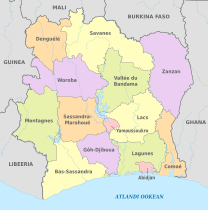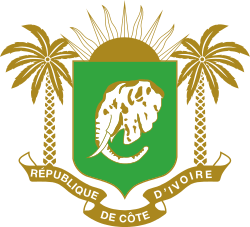Districts of Ivory Coast
| Districts of Ivory Coast | |
|---|---|
|
Also known as: Districts de Côte d'Ivoire | |
 | |
| Location | Republic of Côte d'Ivoire |
| Number | 14 Districts |
| Subdivisions | Regions |
 |
| This article is part of a series on the politics and government of Ivory Coast |
|
|
Government |
|
| Foreign relations |
The districts of Ivory Coast (French: districts de Côte d’Ivoire) are the first-level administrative subdivisions of the country. The districts were created in 2011 in an effort to further decentralise the state,[1][2] but in practice most of them have not yet begun to function as governmental entities.[3]
There are 14 districts, including two autonomous districts around the cities of Yamoussoukro and Abidjan. The remaining 12 districts are further subdivided into 31 regions, which are further subdivided into 108 third-level subdivisions, the departments (French: départements). Departments are subdivided into 510 sub-prefectures (French: sous-préfectures). The lowest level of administrative organisation, which exist in limited numbers, is the commune. Although they are not divided into regions, the autonomous regions do contain departments, sub-prefectures, and communes.
Governance and purpose
Each district is meant to be headed by a governor, who is appointed by the council of ministers (cabinet) of the national government.[4] However, apart from governors for the two autonomous districts, no district governor has yet been nominated; the inaction has largely been in response to apprehensions by the regional prefects that district governors will usurp their authority and responsibilities.[3]
Districts have been given four primary responsibilities:[4]
- to administer major development projects in the district;
- to balance the application of state investments and programmes throughout the district in order to minimise regional disparities;
- to promote the economic and cultural potentials of large groups; and
- to combat regionalism.
Precise distinctions in the jurisdiction of districts as compared to regions has yet to be established. Because of the lack of district governors, the governments of the non-autonomous districts have not yet begun to function.
List of districts
.png)
The following is the list of districts, district capitals and each district's regions:
| Map no. | District | District capital | Regions | Region seat | Population[5] |
|---|---|---|---|---|---|
| 1 | Abidjan (District Autonome d'Abidjan) |
4,707,404 | |||
| 2 | Bas-Sassandra (District du Bas-Sassandra) |
San-Pédro | Gbôklé | Sassandra | 400,798 |
| Nawa | Soubré | 1,053,084 | |||
| San-Pédro | San-Pédro | 826,666 | |||
| 3 | Comoé (District du Comoé) |
Abengourou | Indénié-Djuablin | Abengourou | 560,432 |
| Sud-Comoé | Aboisso | 642,620 | |||
| 4 | Denguélé (District du Denguélé) |
Odienné | Folon | Minignan | 96,415 |
| Kabadougou | Odienné | 193,364 | |||
| 5 | Gôh-Djiboua (District du Gôh-Djiboua) |
Gagnoa | Gôh | Gagnoa | 876,117 |
| Lôh-Djiboua | Divo | 729,169 | |||
| 6 | Lacs (District des Lacs) |
Dimbokro | Bélier | Yamoussoukro[6] | 346,768 |
| Iffou | Daoukro | 311,642 | |||
| Moronou | Bongouanou | 352,616 | |||
| N'Zi | Dimbokro | 247,578 | |||
| 7 | Lagunes (District des Lagunes) |
Dabou | Agnéby-Tiassa | Agboville | 606,852 |
| Grands-Ponts | Dabou | 356,495 | |||
| La Mé | Adzopé | 514,700 | |||
| 8 | Montagnes (District des Montagnes) |
Man | Cavally | Guiglo | 459,964 |
| Guémon | Duékoué | 919,392 | |||
| Tonkpi | Man | 992,564 | |||
| 9 | Sassandra-Marahoué (District du Sassandra-Marahoué) |
Daloa | Haut-Sassandra | Daloa | 1,430,960 |
| Marahoué | Bouaflé | 862,344 | |||
| 10 | Savanes (District des Savanes) |
Korhogo | Bagoué | Boundiali | 375,687 |
| Poro | Korhogo | 763,852 | |||
| Tchologo | Ferkessédougou | 467,958 | |||
| 11 | Vallée du Bandama (District de la Vallée du Bandama) |
Bouaké | Gbêkê | Bouaké | 1,010,849 |
| Hambol | Katiola | 429,977 | |||
| 12 | Woroba (District du Woroba) |
Séguéla | Béré | Mankono | 389,758 |
| Bafing | Touba | 183,047 | |||
| Worodougou | Séguéla | 272,334 | |||
| 13 | Yamoussoukro (District Autonome du Yamoussoukro) |
355,573 | |||
| 14 | Zanzan (District du Zanzan) |
Bondoukou | Bounkani | Bouna | 267,167 |
| Gontougo | Bondoukou | 667,185 | |||
2011 administrative subdivision changes

Prior to September 2011, Ivory Coast's first-level administrative subdivisions were 19 regions. In 2011, the regions were reorganized into the 14 districts (12 regular districts and 2 autonomous districts).[1][2] The following is a summary of how the districts were constructed from the former regions:
- The largest city, Abidjan, and the political capital, Yamoussoukro, and their surrounding areas were split to form autonomous districts. Abidjan was formerly part of Lagunes Region and Yamoussoukro was formerly part of Lacs Region.
- Of the 19 regions, the northern regions of Denguélé, Savanes, Vallée du Bandama, and Zanzan were re-designated as districts with no change in territory.
- The old Agnéby region and what remained of Lagunes Region were merged to form the new Lagunes District.
- The old Bafing and Worodougou Regions were merged to form the new Woroba District.
- The Department of Fresco was transferred from the former Sud-Bandama Region to the Bas-Sassandra Region to form the new Bas-Sassandra District, while the remainder of Sud-Bandama Region merged with Fromager Region to form the new Gôh-Djiboua District.
- The old Dix-Huit Montagnes and Moyen-Cavally Regions merged to form the new Montagnes District.
- The old Haut-Sassandra and Marahoué Regions merged to form the new Sassandra-Marahoué District.
- The old N'Zi-Comoé Region and what remained of Lacs Region were merged to form the new Lacs District.
- The old Moyen-Comoé and Sud-Comoé Regions were merged to form the new Comoé District.
References
- 1 2 "Décentralisation : Le gouvernement créé 12 districts et 30 régions", abidjan.net, 29 September 2011.
- 1 2 Décret n° 2011-263 du 28 septembre 2011 portant organisation du territoire national en Districts et en Régions.
- 1 2 "Les chefs de San Pedro demandent l’érection de leur cité en district autonome", 8 March 2015.
- 1 2 Ordonnance n° 2011-262 du 28 septembre 2011 portant orientation de l'organisation générale de l'administration territoriale de l'Etat.
- ↑ "Districts of Côte d'Ivoire". Statoids. Institut National de la Statistique, Côte d'Ivoire.
- ↑ While Yamoussoukro is the seat of Bélier region, the city itself is not part of the region.